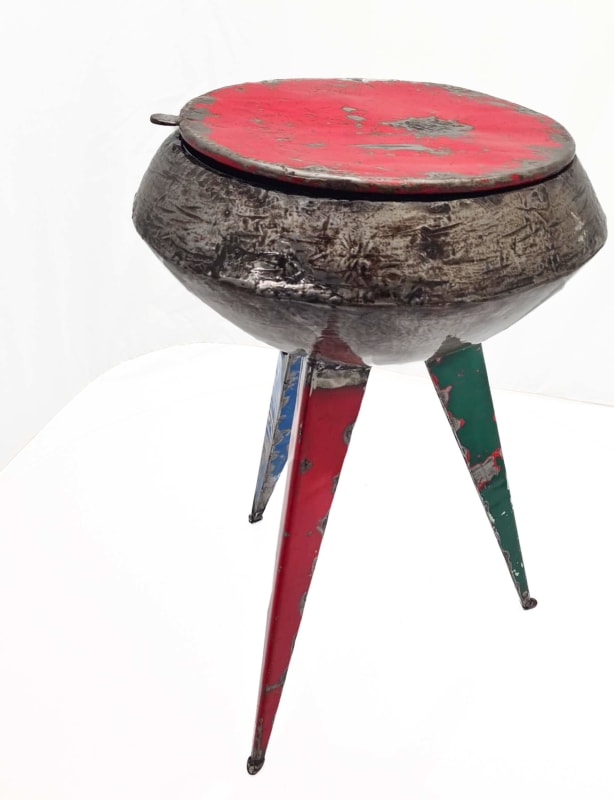Born in 1971 in Ouagadougou, Burkina Faso, Hamed Ouattara is a multidisciplinary artist and designer, founder of the acclaimed Studio Hamed Ouattara (SHO). He began his journey studying accounting while receiving artistic training at the Olorun Foundation, before advancing his design studies at the École Nationale Supérieure de Création Industrielle (ENSCI) in Paris. Upon returning to Burkina Faso, Ouattara transformed his workshop into a creative hub where traditional craftsmanship meets contemporary innovation, merging artisanal heritage with modern design sensibilities.
Artistic Language and Aesthetic
Ouattara's practice is deeply rooted in reuse and transformation. He converts discarded oil barrels, cans, wood, and scrap metals into sculptural design objects. His formal language draws from Sudano-Sahelian architecture, reflecting protective geometries, frontal structures, and suspended volumes that evoke both memory and symbolism of the African landscape. Every piece transcends functionality, becoming a ritual object that bridges the utilitarian with the spiritual.
Social Engagement and Sustainability
SHO is not merely a design studio, it is a social and educational project. Ouattara employs local artisans full-time, offering technical training in welding and metalwork. His approach embodies a circular economy, turning discarded materials into contemporary luxury while tackling environmental and social challenges through creative innovation.
Signature Collection - Bolibana.
Among his most emblematic works is the Bolibana collection, whose name in Bambara means "the unusual end of a journey," symbolizing transformation. In this series, Ouattara crafts consoles, buffets, cabinets, and other furniture from lubricant barrels using traditional techniques such as hammering, welding, and riveting. The aesthetic codes of Sudano-Sahelian architecture are central to the collection, transforming industrial remnants into objects of sculptural elegance and cultural resonance.
International Recognition
Over the past two decades, Ouattara has exhibited widely and been featured in prestigious fairs and residencies:
- 2024: Biennale de Dakar
- 2023: Design Miami Art Fair, Paris Design + Art Fair
- 2019 & 2017: AKAA Art Fair, Paris
- 2016 & 2014: Salon Maison & Objet, Paris
- 2014: Residency at École des Beaux-Arts (ESBA) and Musée d'Art Moderne (MAMA), Algiers, Algeria
His work is represented in major private and institutional collections worldwide, including:
- Denver Art Museum, USA
- Brooklyn Museum, USA
- Vitra Design Museum, Germany
- Société CMC SAS Agnès b, Paris, France
- Matthias and Gervanne Leridon, France
- Rossana Orlandi, Italy
- Centre Pompidou, Paris, France
These acquisitions reflect his status as a leading figure in contemporary African design and highlight the global recognition of his unique fusion of sustainability, craftsmanship, and artistic innovation.
Philosophy and Legacy
For Ouattara, every object carries a story and a material memory traces of its previous life and reflections on global consumption and economic inequalities. By giving new life to discarded materials, he not only contributes to environmental sustainability but also asserts a design philosophy rooted in African identity, resilience, and creative innovation.
Exhibition at OOA Gallery - METAL. Art & Design
In METAL. Art & Design, OOA Gallery presents a curated selection of Ouattara's most emblematic works, emphasizing the connection between material intelligence, cultural heritage, and contemporary aesthetics. Signature pieces such as his tabourets, plates, and fruit bowls, crafted from upcycled oil barrels and industrial metals, showcase his mastery in transforming everyday objects into refined, sculptural artifacts. The geometric silhouettes of the tabourets reflect Sudano-Sahelian architecture, while the plates and bowls celebrate imperfection, resilience, and transformation.
Through these creations, Hamed Ouattara reinvents metal as a medium of renewal, transforming industrial remnants into objects of contemporary elegance that carry both the memory of their origins and the promise of sustainable design. His work exemplifies craftsmanship as cultural resistance and art as a tool for reimagining the future.


